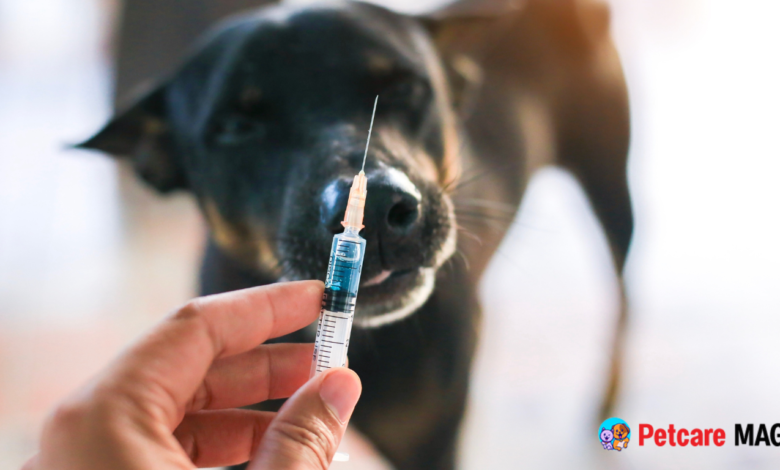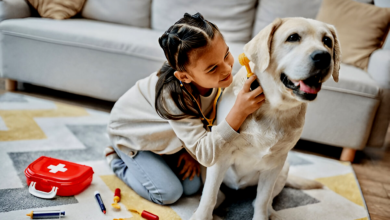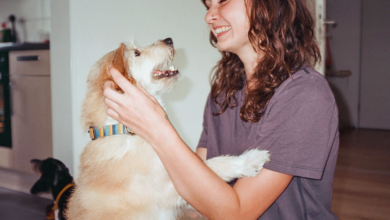
Top 10 Best Medications for Dog Anxiety

Dogs can experience a wide variety of anxiety and behavioural issues, some of which can be so severe that they make the dog almost unable to function normally. As people who care for pets, we want to be of assistance, but the many different treatment and pharmaceutical options make our heads spin. This article describes the top 10 Medications for Dog Anxiety.
Your family doctor or animal hospital is the best place to start looking for information on treating your dog’s anxiety. Your veterinarian can begin offering treatment options once they have examined your dog and given him a clean bill of health. To effectively treat anxiety, it is typically necessary to enlist the assistance of a veterinary behaviourist or a certified dog trainer. Your dog’s anxiousness could be treated with medication, which your veterinarian can suggest taking as part of the plan to modify your pet’s behaviour.
How Dog Anxiety Medications Work
You will also need to set behaviour-modification protocols for your dog, regardless of which medicine your veterinarian decides to prescribe, to assist them in working through their anxiety.
Because anxiety in dogs can manifest in many ways (including fear, tension, impulsivity, compulsive behaviours, aggression, panic disorders, and noise phobias or aversions), some drugs can be used both temporarily and on a long-term basis to treat the condition. There are no quick cures, and working with a qualified behaviourist or trainer is the best method to assist in resolving the odd behaviour that your pet is exhibiting. This is true regardless of the sort of medication that your veterinarian prescribes for your dog.
Treatment for illnesses that require long-term medical care may need to be administered to dogs for four to six weeks before the full benefit of the drug can be observed. Furthermore, treatment must be maintained for at least two months after a response is considered successful.
Long-Term vs Short-Term Treatment
While some dogs can eventually be weaned off of anti-anxiety meds, other dogs require treatment for longer. Dogs taking the same medication for six months or longer should have annual checkups and blood work performed, in addition to periodic behaviour reevaluations, to confirm that the treatment plan they are currently undergoing is still the most appropriate choice for their requirements.
Some anxiety or stress triggers, such as driving in the car, visits to the veterinarian, or thunderstorms, may benefit from using short-term drugs that have an immediate effect and only continue to work for a limited time. These prescription drugs are often intended to be taken infrequently.
Common Medications for Dog Anxiety

Both fluoxetine and sileo have been given the go-ahead by the FDA for canine use. All other drugs are intended for human consumption but are sometimes given to dogs off-label. The terms “off-label” and “extra-label” are preferred when referring to drug usage in a way or in a species not listed on the medication label. Only a veterinarian who has direct and personal knowledge of your dog and only in situations in which no other treatments are acceptable for a particular dog’s conditions should use the medication in a manner that is considered off-label or extra-label.
Read More: Vitamin C for Dogs:10 Best Benefits- PetCare Mag
Because these medications are frequently administered in tablets that are too large for dogs, it may be necessary to have a speciality pharmacy mix them into a flavoured chewable tablet, capsule, liquid, or medication applied to the skin transdermally.
The following is a detailed list of the most frequently prescribed drugs to treat anxiety in dogs.
Jump to a specific medication:
- Alprazolam (Xanax)
- Amitriptyline
- Buspirone
- Clomipramine (Clomicalm)
- Dexmedetomidine (Sileo)
- Diazepam (Valium)
- Fluoxetine (Reconcile or Prozac)
- Lorazepam (Ativan)
- Paroxetine (Paxil)
- Sertraline (Zoloft)
Alprazolam (Xanax)
Indications: phobias, fear, panic disorders
Although alprazolam is most commonly used to help dogs that feel frightened during thunderstorms, the medication may also treat anxiety brought on by other types of situations.
It belongs to the sedatives known as benzodiazepines, which slow down activity in specific central nervous system regions (the precise mechanism of action has not yet been determined). This drug has a fast onset of action and may be used four times daily. Its duration of action is relatively brief. Alprazolam is most effective when administered at the first sign of anxiety, ideally thirty to sixty minutes before exposing your puppy to the stimulus causing it. It is not recommended to cease taking this drug suddenly if it is used for a prolonged period.
Potential side effects include:
- Lethargy
- Sedation
- Incoordination
- Increased appetite
Amitriptyline
Indications: Separation anxiety, reactivity, anxious aggression, or more generalized anxious tendencies
Amitriptyline is a type of antidepressant medication known as tricyclic. It works in part by elevating the chemical messengers serotonin and norepinephrine levels found in the nervous system. These messengers are responsible for regulating mood. Pets diagnosed with diabetes or epilepsy should not be given it under any circumstances.
It can take one to four weeks for this drug to start working, and it must be taken twice a day. Tablets of amitriptyline can be taken with or without food, according to the individual’s preference. If the dog has been taking amitriptyline for longer than a week or two, the medication dosage should be reduced in stages before it is stopped completely.
Potential side effects include:
- Constipation
- Lethargy
- Sedation
- Holding of urine
- Dilated pupils
Buspirone
Indications: Phobias, social anxiety, mild generalized anxiety
Anxiolytic medications that belong to the azaperone class include buspirone. Because this drug needs to be taken regularly for it to succeed, it is not beneficial for dogs who suffer from situational concerns such as a fear of thunderstorms.
It works as a modest anti-anxiety medicine because it activates serotonin and dopamine receptors within the brain. This may be one of the main reasons why it is effective.
It may be necessary to administer this drug anywhere from twice to three times daily, and the onset of its effects can take as long as six weeks. Buspirone is most commonly administered as a pill, which can be taken with or without food.
Potential side effects include:
- Loss of appetite
- Vomiting
- Sedation
Clomipramine (Clomicalm)
Indications: Separation anxiety, situational anxiety, compulsive disorders, irritability
Clomipramine is the first therapy for separation anxiety in dogs approved by the FDA. Getting a prescription for it is also possible to treat other kinds of stress.
It is a tricyclic antidepressant medication that partially works by boosting the levels of the chemical messengers serotonin and norepinephrine found in the neurological system. These chemical messengers are responsible for affecting mood.
It may take this medicine anywhere from four to six weeks before it begins to have its therapeutic impact, and it may take up to two months before it can be determined whether or not it is beneficial for a dog. It is recommended that clomipramine be administered twice daily and that the patient not suddenly cease taking it.
Tablets of clomipramine can be taken with or without food, depending on the patient’s preference.
Potential side effects include:
- Lethargy
- Vomiting
- Diarrhoea
- Agitation
- Sedation
- Increased heart rate
- Dry mouth
- Decreased appetite
Dexmedetomidine (Sileo)
Indications: Situational anxiety, noise phobias, aversions
The FDA has given its blessing to using Sileo to treat dogs suffering from noise phobia. It is an alpha-2 adrenoceptor agonist that partially acts by suppressing activity in particular areas of the brain, which, among other effects, leads to decreased anxiety levels.
The optimal time to administer the medication is thirty to sixty minutes before a noisy event known to cause the dog anxiety or at the first sign that the dog is becoming worried.
Sileo is delivered in a multidose tube as a transmucosal gel. It is not recommended that the medication be taken; instead, it should be put between the cheek and the gums to absorb through the mucus membranes. When you are handling the syringe and giving the medication, you will need to be sure that you are wearing disposable and waterproof gloves.
Potential side effects include:
- Lethargy
- Vomiting
- Diarrhoea
- Facial swelling
- Sedation
- Decreased heart rate
- Dry eye
Diazepam (Valium)
Indications: Situational anxiety, panic disorders, noise aversion, phobia
It is recommended that dogs be administered diazepam 30–60 minutes before an event that is known to trigger anxiety whenever it is possible to do so. The medication can also be administered at the first sign that a dog feels worried; however, it is most effective when issued in advance.
Sedatives of the benzodiazepine class, like this one, function by lowering the amount of activity in some areas of the central nervous system. This particular medication is a benzodiazepine. Diazepam is a drug with a rapid onset of action that can be used up to four times daily at the maximum recommended dosage. It is not recommended to cease taking this drug suddenly if it is used for a prolonged period.
Potential side effects include:
- Lethargy
- Sedation
- Incoordination
- Increased appetite
- Agitation
- Aggression
Fluoxetine (Reconcile or Prozac)
Indications: Separation anxiety, aggression, compulsive behaviours, impulsivity
It is recommended that dogs be administered diazepam 30–60 minutes before an event that is known to trigger anxiety whenever it is possible to do so. The medication can also be administered at the first sign that a dog feels worried; however, it is most effective when issued in advance.
Sedatives of the benzodiazepine class, like this one, function by lowering the amount of activity in some areas of the central nervous system. This particular medication is a benzodiazepine. Diazepam is a drug with a rapid onset of action that can be used up to four times daily at the maximum recommended dosage. It is not recommended to cease taking this drug suddenly if it is used for a prolonged period.
Potential side effects include:
- Constipation
- Loss of appetite
- Vomiting
- Diarrhoea
- Agitation
- Sedation
- Lethargy
- Urine holding
Lorazepam (Ativan)
Indications: Situational anxiety, phobias, fear anxiety, panic disorders
It takes around half an hour for lorazepam to begin exerting its influence once it has been taken. Lorazepam should be administered to dogs as early as feasible on the day before an event known to cause them anxiety if possible. It is also possible to help the medication at the first sign that a dog is beginning to feel stressed. If you have been taking this drug for an extended period, you should not stop taking it suddenly.
This drug is categorized as a benzodiazepine, and its mechanism of action involves increasing the activity of gamma-aminobutyric acid (GABA) in the brain. Your pet will feel more relaxed due to the soothing effects of GABA, which works by blocking the effects of excitatory nerve signals in the brain.
Potential side effects include:
- Lethargy
- Sedation
- Incoordination
- Increased appetite
- Excitement
- Aggressive behaviour
Paroxetine (Paxil)
Indications: Generalized anxiety, anxious aggression and anxiety-related behaviours, fear of noises, self-mutilation
Paroxetine is a type of medication known as a selective serotonin-reuptake inhibitor (SSRI). This class of drugs works by preventing serotonin, a chemical messenger in the nervous system, from being removed from the brain through receptors in the brain. This makes it possible for higher quantities of serotonin in the brain.
Read More: Best Dry Cat Foods 2023: Top 9 Picks for Good Health
It can take paroxetine anywhere from four to six weeks to start working, and it should be taken once daily. If your dog has been taking this medication for an extended period, you should not suddenly stop giving it to them.
Potential side effects include:
- Constipation
- Loss of appetite
- Drooling
- Vomiting
- Diarrhoea
- Agitation
- Sedation
- Lethargy
- Urine holding
Sertraline (Zoloft)
Indications: separation anxiety, anxiety disorders, impulsivity disorders, thunderstorm phobia, compulsive behaviours, fear-based aggression
Known scientifically as an SSRI, or selective serotonin reuptake inhibitor, sertraline is a drug used to treat depression. Because SSRIs prevent serotonin receptors in the brain from eliminating the chemical messenger serotonin produced by the nervous system, which increases serotonin levels in the brain.
Serotonin plays a role in the regulation of mood. Increased levels of the neurotransmitter serotonin have been linked to decreased anxiety and reduced impulsivity and hostility.
It may take four to six weeks for sertraline, like other SSRIs, to have its full impact, and the medication should be taken regularly. If a dog has been taking sertraline for two months or more, weaning them off the medicine gradually rather than abruptly stopping their treatment may be advantageous.
Potential side effects include:
- Lethargy
- Loss of appetite
- Vomiting
- Diarrhoea
- Agitation
- Sedation
- Urine holding







One Comment